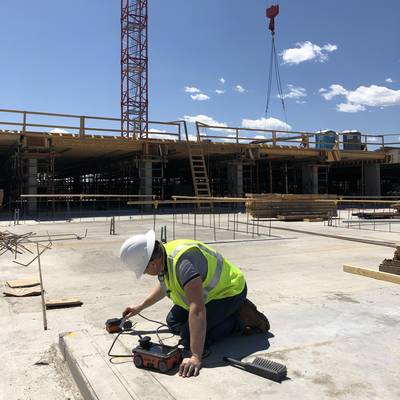Effective Concrete Scanning Methods for Construction Jobs
Wiki Article
Beyond the Surface Area: Leveraging Advanced Concrete Scanning Techniques for Unmatched Precision and Insight
In the world of building and construction and facilities maintenance, the pursuit for accuracy and thoroughness is incessant. Advanced concrete scanning methods have emerged as essential devices in this pursuit, offering a glance underneath the surface area to reveal a world of crucial understandings. By taking advantage of innovative innovations, specialists can discover anomalies, evaluate the condition of concrete frameworks, and make notified choices that form the training course of jobs. The implications of these methods expand much beyond simple surface-level assessments, assuring a depth of precision and understanding that is unequaled.Importance of Advanced Concrete Scanning
The relevance of utilizing sophisticated concrete scanning strategies exists in the unequaled accuracy they offer for discovering sub-surface abnormalities and guaranteeing architectural honesty. By employing cutting-edge technologies such as ground-penetrating radar (GPR), electromagnetic induction, and progressed sonar imaging, building experts can dig under the surface area of concrete frameworks with a degree of accuracy that far surpasses conventional assessment techniques. Concrete Scanning. These methods allow the recognition of hidden hazards like rebar corrosion, voids, conduits, or post-tension cables that could jeopardize the stability and security of a structure in timeAdditionally, advanced concrete scanning provides indispensable understandings into the overall condition of a concrete component without the demand for invasive procedures, decreasing the threat of creating damage during the analysis procedure. The capability to determine the precise place and depth of possible problems enables targeted repair work and maintenance, ultimately lengthening the life-span of the framework and optimizing its performance. Essentially, the importance of advanced concrete scanning can not be overemphasized in the world of construction and framework upkeep, where precision and dependability are vital.
Types of Cutting-Edge Technologies

Abnormalities and Problem Discovery

In enhancement to GPR, concrete scanning techniques like thermography and impact-echo testing are likewise effective in discovering anomalies and problems. By leveraging these advanced techniques, professionals can proactively resolve architectural concerns, guaranteeing the longevity and safety of concrete structures.
Assessing Concrete Condition
Exactly how can designers properly evaluate the condition of concrete frameworks to ensure their longevity and safety? Different advanced concrete scanning methods are used for this function. Ground-penetrating radar (GPR) is frequently utilized to assess the internal framework of concrete, finding voids, cracks, and various other anomalies that might endanger its stamina.Moreover, aesthetic evaluation remains an essential component of concrete problem analysis. Engineers aesthetically analyze the surface area for indications of degeneration, such as spalling, cracking, or discoloration. Combining non-destructive screening techniques with visual assessments permits an extensive examination of concrete problem, enabling designers to determine prospective issues at an early stage and implement prompt upkeep or repairs. By leveraging these sophisticated strategies, engineers can ensure the long-lasting sturdiness and security of concrete structures.
Enhancing Decision-Making Processes
In the realm of facilities management, maximizing decision-making procedures is critical for making certain the effective upkeep and long life of concrete structures. Improved decision-making procedures in concrete management involve utilizing innovative scanning strategies to collect in-depth information on the problem of frameworks. By leveraging modern technologies such as ground-penetrating radar and 3D imaging, stakeholders can make Your Domain Name educated choices regarding repair work, substitute, or support methods.These progressed scanning techniques give very useful understandings right into the interior structure of concrete, identifying prospective concerns such as spaces, splits, or rust that might not show up externally. This level of in-depth information enables for positive maintenance planning, lessening the risk of architectural failures and enhancing the total life-span of concrete structures.
Moreover, by incorporating digital documentation and evaluation devices right into the decision-making process, stakeholders can track the evolution of concrete problems gradually, enabling predictive upkeep strategies and maximizing resource allotment. Ultimately, the combination of sophisticated concrete scanning strategies boosts decision-making procedures by offering unequaled precision, understanding, and effectiveness in facilities management.
Final Thought
To conclude, progressed concrete scanning methods provide unrivaled accuracy and understanding in discovering check that anomalies, issues, and examining the problem of concrete frameworks. By leveraging cutting-edge innovations, decision-making processes can be boosted, bring about more reliable and educated services for keeping and fixing concrete framework. These methods play an essential role in making sure the safety and long life of concrete frameworks, making them an important tool in the area of building and design.Moreover, progressed concrete scanning offers indispensable understandings right into the overall condition of a concrete aspect without the requirement for invasive steps, reducing the risk of causing damages during the assessment procedure - Concrete Scanning. One more ingenious technology is 3D X-ray scanning, which gives thorough photos of the inner structure of concrete, using useful information without the need for destructive screening. Furthermore, Concrete Cover Meters are made use of to determine the thickness of concrete cover over support bars accurately. Improved decision-making procedures in concrete monitoring include utilizing innovative scanning strategies to gather comprehensive data on the condition of structures.In verdict, advanced concrete scanning methods provide unmatched precision and insight in discovering abnormalities, problems, and evaluating the problem of concrete frameworks
Report this wiki page